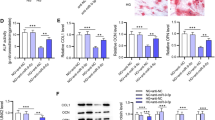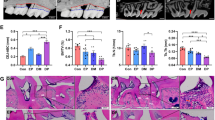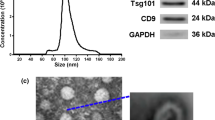Abstract
Bone marrow mesenchymal stem cells (BMSCs) are a type of adult stem cells that originate from the mesoderm and have important roles in the body because of their self-renewal and multidirectional differentiation potential. Now it has been proved that BMSCs are closely related to the development of osteoporosis (OP). There is growing evidence that lncRNAs are involved in regulating the pyroptosis of BMSCs. And advanced glycation end-products (AGEs) have been recognized as NOD-like receptor family pyrin domain-containing protein 3 (NLRP3) inflammasome activators. In this study, we aimed to explore the role of lncRNA ORLNC1 (NONMMUT016106.2) on the pyroptosis of BMSCs under CML (Nε-(carboxymethyl) lysine, the most common AGEs) treatment and its specific molecular mechanisms. Our study revealed that CML treatment promoted pyroptosis of BMSCs and upregulated ORLNC1 expression. As a competing endogenous RNA (ceRNA) of miR-200b-3p, the level of ORLNC1 was negatively correlated with miR-200b-3p. Foxo3 was a target of miR-200b-3p and ORLNC1 promoted BMSCs pyroptosis induced by CML through targeting miR-200b-3p/Foxo3 pathway.
Graphical Abstract








Similar content being viewed by others
Data Availability
The data that support the findings of this study are available from the corresponding authors on reasonable request.
References
Curtis, E. M., et al. (2016). Recent advances in the pathogenesis and treatment of osteoporosis. Clinical Medicine (London, England), 16(4), 360–364.
Khosla, S., & Hofbauer, L. C. (2017). Osteoporosis treatment: Recent developments and ongoing challenges. The Lancet Diabetes and Endocrinology, 5(11), 898–907.
Kling, J. M., Clarke, B. L., & Sandhu, N. P. (2014). Osteoporosis prevention, screening, and treatment: A review. Journal of Women’s Health (2002), 23(7), 563–572.
Bartolucci, J., et al. (2017). Safety and efficacy of the intravenous infusion of umbilical cord mesenchymal stem cells in patients with heart failure: A phase 1/2 randomized controlled trial (RIMECARD Trial [Randomized Clinical Trial of Intravenous Infusion Umbilical Cord Mesenchymal Stem Cells on Cardiopathy]). Circulation Research, 121(10), 1192–1204.
Guo, Y., et al. (2017). Succinate and its G-protein-coupled receptor stimulates osteoclastogenesis. Nature Communications, 8, 15621.
Wu, J. Y., et al. (2011). Gsα enhances commitment of mesenchymal progenitors to the osteoblast lineage but restrains osteoblast differentiation in mice. The Journal of Clinical Investigation, 121(9), 3492–3504.
D’Souza, S., et al. (2011). Gfi1 expressed in bone marrow stromal cells is a novel osteoblast suppressor in patients with multiple myeloma bone disease. Blood, 118(26), 6871–6880.
Iyer, M. K., et al. (2015). The landscape of long noncoding RNAs in the human transcriptome. Nature Genetics, 47(3), 199–208.
Wu, Y., et al. (2019). The role of lncRNAs in the distant metastasis of breast cancer. Frontiers in Oncology, 9, 407.
Wang, Y., et al. (2015). Genome-wide microarray analysis of long non-coding RNAs in eutopic secretory endometrium with endometriosis. Cellular Physiology and Biochemistry, 37(6), 2231–2245.
Zhao, D., et al. (2019). LncRNA HIF2PUT inhibited osteosarcoma stem cells proliferation, migration and invasion by regulating HIF2 expression. Artif Cells Nanomed Biotechnol, 47(1), 1342–1348.
Zhang, Y., et al. (2019). LncRNA MALAT1 promotes osteoarthritis by modulating miR-150-5p/AKT3 axis. Cell & Bioscience, 9, 54.
Yang, L., et al. (2019). The long non-coding RNA-ORLNC1 regulates bone mass by directing mesenchymal stem cell fate. Molecular Therapy, 27(2), 394–410.
Shirasuna, K., Karasawa, T., & Takahashi, M. (2020). Role of the NLRP3 inflammasome in preeclampsia. Front Endocrinol (Lausanne), 11, 80.
Chen, L., et al. (2018). Neutrophil extracellular traps promote macrophage pyroptosis in sepsis. Cell Death & Disease, 9(6), 597.
Deng, M., et al. (2018). The endotoxin delivery protein HMGB1 mediates caspase-11-dependent lethality in sepsis. Immunity, 49(4), 740-753 e7.
Han, S. Y., et al. (2019). High-mobility group box 1 is associated with the inflammatory pathogenesis of graves’ orbitopathy. Thyroid, 29(6), 868–878.
Kaur, H., Kamalov, M., & Brimble, M. A. (2016). Chemical synthesis of peptides containing site-specific advanced glycation endproducts. Accounts of Chemical Research, 49(10), 2199–2208.
Li, C. J., et al. (2015). MicroRNA-188 regulates age-related switch between osteoblast and adipocyte differentiation. The Journal of Clinical Investigation, 125(4), 1509–1522.
Zhang, N., et al. (2019). LncRNA MSC-AS1 promotes osteogenic differentiation and alleviates osteoporosis through sponging microRNA-140-5p to upregulate BMP2. Biochemical and Biophysical Research Communications, 519(4), 790–796.
Hou, C., Wang, D., & Zhang, L. (2019). MicroRNA34a3p inhibits proliferation of rheumatoid arthritis fibroblastlike synoviocytes. Molecular Medicine Reports, 20(3), 2563–2570.
Yu, L., et al. (2018). LncRNA-PCAT1 targeting miR-145-5p promotes TLR4-associated osteogenic differentiation of adipose-derived stem cells. Journal of Cellular and Molecular Medicine, 22(12), 6134–6147.
Ding, D., et al. (2018). LncRNA H19/miR-29b-3p/PGRN Axis promoted epithelial-mesenchymal transition of colorectal cancer cells by acting on Wnt signaling. Molecules and Cells, 41(5), 423–435.
Wang, K., et al. (2014). The long noncoding RNA CHRF regulates cardiac hypertrophy by targeting miR-489. Circulation Research, 114(9), 1377–1388.
Dominici, M., et al. (2006). Minimal criteria for defining multipotent mesenchymal stromal cells. The international society for cellular therapy position statement. Cytotherapy, 8(4), 315–7.
Gangoiti, M. V., et al. (2008). Opposing effects of bisphosphonates and advanced glycation end-products on osteoblastic cells. European Journal of Pharmacology, 600(1–3), 140–147.
Weinberg, E., Maymon, T., & Weinreb, M. (2014). AGEs induce caspase-mediated apoptosis of rat BMSCs via TNFα production and oxidative stress. Journal of Molecular Endocrinology, 52(1), 67–76.
Wang, L., et al. (2017). NLRP3 inflammasome activation in mesenchymal stem cells inhibits osteogenic differentiation and enhances adipogenic differentiation. Biochemical and Biophysical Research Communications, 484(4), 871–877.
Yan, B., et al. (2020). Stem cell-derived exosomes prevent pyroptosis and repair ischemic muscle injury through a novel exosome/circHIPK3/ FOXO3a pathway. Theranostics, 10(15), 6728–6742.
Liang, C., et al. (2020). Exosomes of Human Umbilical Cord MSCs Protect Against Hypoxia/Reoxygenation-Induced Pyroptosis of Cardiomyocytes via the miRNA-100–5p/FOXO3/NLRP3 Pathway. Front Bioeng Biotechnol, 8, 615850.
Li, X., et al. (2014). MicroRNA-30d regulates cardiomyocyte pyroptosis by directly targeting foxo3a in diabetic cardiomyopathy. Cell Death Dis, 5, e1479.
Pu, Q., et al. (2017). Atg7 Deficiency Intensifies Inflammasome Activation and Pyroptosis in Pseudomonas Sepsis. The Journal of Immunology, 198(8), 3205–3213.
Pfalzgraff, A., et al. (2017). Synthetic anti-endotoxin peptides inhibit cytoplasmic LPS-mediated responses. Biochemical Pharmacology, 140, 64–72.
Aglietti, R. A., & Dueber, E. C. (2017). Recent Insights into the Molecular Mechanisms Underlying Pyroptosis and Gasdermin Family Functions. Trends in Immunology, 38(4), 261–271.
Man, S. M., Karki, R., & Kanneganti, T. D. (2017). Molecular mechanisms and functions of pyroptosis, inflammatory caspases and inflammasomes in infectious diseases. Immunological Reviews, 277(1), 61–75.
Miao, E. A., et al. (2010). Caspase-1-induced pyroptosis is an innate immune effector mechanism against intracellular bacteria. Nature Immunology, 11(12), 1136–1142.
Qiu, Z., et al. (2019). Lipopolysaccharide (LPS) aggravates high glucose- and hypoxia/reoxygenation-induced injury through activating ROS-Dependent NLRP3 inflammasome-mediated pyroptosis in H9C2 cardiomyocytes. Journal of Diabetes Research, 2019, 8151836.
Doherty, T. A., Brydges, S. D., & Hoffman, H. M. (2011). Autoinflammation: Translating mechanism to therapy. Journal of Leukocyte Biology, 90(1), 37–47.
Wen, H., Ting, J. P., & O’Neill, L. A. (2012). A role for the NLRP3 inflammasome in metabolic diseases–did Warburg miss inflammation? Nature Immunology, 13(4), 352–357.
Wen, H., et al. (2011). Fatty acid-induced NLRP3-ASC inflammasome activation interferes with insulin signaling. Nature Immunology, 12(5), 408–415.
Yamagishi, S. (2011). Role of advanced glycation end products (AGEs) in osteoporosis in diabetes. Current Drug Targets, 12(14), 2096–2102.
Reynaert, N. L., et al. (2016). Advanced glycation end products and their receptor in age-related, non-communicable chronic inflammatory diseases; Overview of clinical evidence and potential contributions to disease. International Journal of Biochemistry & Cell Biology, 81(Pt B), 403–418.
Kanazawa, I. (2017). Interaction between bone and glucose metabolism [Review]. Endocrine Journal, 64(11), 1043–1053.
Notsu, M., et al. (2014). Advanced glycation end product 3 (AGE3) suppresses the mineralization of mouse stromal ST2 cells and human mesenchymal stem cells by increasing TGF-β expression and secretion. Endocrinology, 155(7), 2402–2410.
Li, D., et al. (2017). The microRNAs miR-200b-3p and miR-429-5p target the LIMK1/CFL1 pathway to inhibit growth and motility of breast cancer cells. Oncotarget, 8(49), 85276–85289.
Liu, J., Wang, L., & Li, X. (2018). HMGB3 promotes the proliferation and metastasis of glioblastoma and is negatively regulated by miR-200b-3p and miR-200c-3p. Cell Biochemistry and Function, 36(7), 357–365.
Nwaeburu, C. C., et al. (2017). Quercetin-induced miR-200b-3p regulates the mode of self-renewing divisions in pancreatic cancer. Molecular Cancer, 16(1), 23.
Wu, J., et al. (2017). Effect of the interaction between MiR-200b-3p and DNMT3A on cartilage cells of osteoarthritis patients. Journal of Cellular and Molecular Medicine, 21(10), 2308–2316.
Han, N., et al. (2020). YAP1 is required for the angiogenesis in retinal microvascular endothelial cells via the inhibition of MALAT1-mediated miR-200b-3p in high glucose-induced diabetic retinopathy. Journal of Cellular Physiology, 235(2), 1309–1320.
Bosch, T. C., et al. (2010). The Hydra polyp: Nothing but an active stem cell community. Development, Growth & Differentiation, 52(1), 15–25.
Boehm, A. M., Rosenstiel, P., & Bosch, T. C. (2013). Stem cells and aging from a quasi-immortal point of view. BioEssays, 35(11), 994–1003.
Banasik, K., et al. (2011). The FOXO3A rs2802292 G-allele associates with improved peripheral and hepatic insulin sensitivity and increased skeletal muscle-FOXO3A mRNA expression in twins. Journal of Clinical Endocrinology and Metabolism, 96(1), E119–E124.
He, Q., et al. (2014). Shorter men live longer: association of height with longevity and FOXO3 genotype in American men of Japanese ancestry. PLoS One, 9(5), e94385.
Zhang, X., et al. (2011). Akt, FoxO and regulation of apoptosis. Biochimica et Biophysica Acta, 1813(11), 1978–1986.
Peng, S. L. (2007). Immune regulation by Foxo transcription factors. Autoimmunity, 40(6), 462–469.
You, H., et al. (2006). FOXO3a-dependent regulation of Puma in response to cytokine/growth factor withdrawal. Journal of Experimental Medicine, 203(7), 1657–1663.
Becker, T., et al. (2010). FOXO-dependent regulation of innate immune homeostasis. Nature, 463(7279), 369–373.
Acknowledgements
This work was supported by 2019 Hebei Provincial Government-Funded Clinical Talents Training and Basic Research projects from China.(2019-14)We would like to thank all the researchers and study participants for their contributions.
Funding
This work was supported by 2019 Hebei Provincial Government-Funded Clinical Talents Training and Basic Research projects from China. (2019–14).
Author information
Authors and Affiliations
Contributions
Conceptualization: Lili Zhang; Data curation: Shilun Li; Formal analysis: Juan Li; Funding acquisition: Yukun Li; Methodology: Shilun Li; Project administration: Lili Zhang and Shilun Li; Writing—original draft: Lili Zhang; Writing—review & editing: Lili Zhang and Juan Li. All authors and participants reviewed the paper and approved the final manuscript.
Corresponding author
Ethics declarations
Ethics Approval and Consent to Participate
All experimental processes were performed in strict compliance with the regulations of the Ethics Committee of Hebei Medical University. Also, all animal experiments were approved by the Ethics Committee of Hebei Medical University.
Consent for Publication
Not applicable.
Declarations of Interest
none.
Competing Interests
The authors declare that they have no competing interests.
Additional information
Publisher's Note
Springer Nature remains neutral with regard to jurisdictional claims in published maps and institutional affiliations.
Rights and permissions
About this article
Cite this article
Zhang, L., Li, S., Li, J. et al. LncRNA ORLNC1 Promotes Bone Marrow Mesenchyml Stem Cell Pyroptosis Induced by Advanced Glycation End Production by Targeting miR-200b-3p/Foxo3 Pathway. Stem Cell Rev and Rep 17, 2262–2275 (2021). https://doi.org/10.1007/s12015-021-10247-2
Accepted:
Published:
Issue Date:
DOI: https://doi.org/10.1007/s12015-021-10247-2




